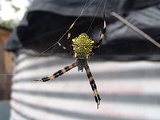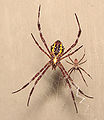
Argiope appensa
Encyclopedia
Argiope appensa is a spider
that occurs on several islands in the Western Pacific Ocean. It has been introduced to Hawai'i, and is found on Taiwan
and New Guinea
. It inhabits a wide variety of habitats, from coasts to forests.
 Females reach a body length of up to 7 cm and are strikingly black and yellow, while the brown males reach only about 2 cm. http://www.birdinghawaii.co.uk/nonavianground2.htm
Females reach a body length of up to 7 cm and are strikingly black and yellow, while the brown males reach only about 2 cm. http://www.birdinghawaii.co.uk/nonavianground2.htm
In Hawai'i they are referred to as Hawaiian garden spiders'.
On Guam
, where Argipoe appensa is ubiquitous, it is frequently visited by Argyrodes argentatus
. Locals there refer to them as banana spiders. Following the introduction of the brown tree snake and the subsequent extinction or near-extinction of many of the island's small birds, spider populations on Guam exploded in response to decreasing predation and competition. Nature writer David Quammen
has called Argiope appensa "almost certainly one of the larger species" which were encountered in vast numbers during his research trip to Guam for the book The Song of the Dodo.
" of the Lost
TV series, which is filmed on location in Hawai'i. It is there named Latrodectus regina (or Medusa Spider), a fictional species of widow spider
, in the family Theridiidae
. The "males" that run for the female are also females, as the males are much smaller.
Spider
Spiders are air-breathing arthropods that have eight legs, and chelicerae with fangs that inject venom. They are the largest order of arachnids and rank seventh in total species diversity among all other groups of organisms...
that occurs on several islands in the Western Pacific Ocean. It has been introduced to Hawai'i, and is found on Taiwan
Taiwan
Taiwan , also known, especially in the past, as Formosa , is the largest island of the same-named island group of East Asia in the western Pacific Ocean and located off the southeastern coast of mainland China. The island forms over 99% of the current territory of the Republic of China following...
and New Guinea
New Guinea
New Guinea is the world's second largest island, after Greenland, covering a land area of 786,000 km2. Located in the southwest Pacific Ocean, it lies geographically to the east of the Malay Archipelago, with which it is sometimes included as part of a greater Indo-Australian Archipelago...
. It inhabits a wide variety of habitats, from coasts to forests.
Description

In Hawai'i they are referred to as Hawaiian garden spiders'.
On Guam
Guam
Guam is an organized, unincorporated territory of the United States located in the western Pacific Ocean. It is one of five U.S. territories with an established civilian government. Guam is listed as one of 16 Non-Self-Governing Territories by the Special Committee on Decolonization of the United...
, where Argipoe appensa is ubiquitous, it is frequently visited by Argyrodes argentatus
Argyrodes argentatus
Argyrodes argentatus is a kleptoparasitic spider.In Singapore, it is often seen in webs of Nephila antipodiana.On Guam it can often be found hanging in webs of the much larger spider Argiope appensa: while A. appensa can reach a body length of about 7 cm, A...
. Locals there refer to them as banana spiders. Following the introduction of the brown tree snake and the subsequent extinction or near-extinction of many of the island's small birds, spider populations on Guam exploded in response to decreasing predation and competition. Nature writer David Quammen
David Quammen
David Quammen is a science, nature and travel writer whose work has appeared in publications such as National Geographic, Outside, Harper's, Rolling Stone, and The New York Times Book Review....
has called Argiope appensa "almost certainly one of the larger species" which were encountered in vast numbers during his research trip to Guam for the book The Song of the Dodo.
In popular culture
This species was used in episode "ExposéExposé (Lost)
"Exposé" is the 14th episode of the 3rd season and 63rd episode overall of the American Broadcasting Company 's serial drama television series Lost. It was aired as on ABC in the United States and on CTV in Canada on March 28, 2007...
" of the Lost
Lost (TV series)
Lost is an American television series that originally aired on ABC from September 22, 2004 to May 23, 2010, consisting of six seasons. Lost is a drama series that follows the survivors of the crash of a commercial passenger jet flying between Sydney and Los Angeles, on a mysterious tropical island...
TV series, which is filmed on location in Hawai'i. It is there named Latrodectus regina (or Medusa Spider), a fictional species of widow spider
Widow spider
Latrodectus is a genus of spider, in the family Theridiidae, which contains 31 recognized species. The common name widow spiders is sometimes applied to members of the genus due to the behavior of the female of eating the male after mating, although sometimes the males of some species are not eaten...
, in the family Theridiidae
Theridiidae
Theridiidae is a large family of spiders, also known as the tangle-web spiders, cobweb spiders and comb-footed spiders. The diverse family includes over 2200 species in over 100 genera) of three-dimensional space-web-builders found throughout the world...
. The "males" that run for the female are also females, as the males are much smaller.

